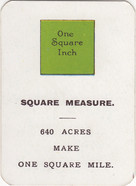Published in 1910 By J.Jaques & Son Ltd of Hatton Garden, London. Weights & Measures is a simple card game, played like Happy Families but instead of collecting nuclear families the aim is to collect groups of cards defining commonly used systems of measurement. Commonly used that is in early 20th Century Britain and the Empire.

Weights & Measures Box Front
Each measurement scale has a key card: Long Measure, Square Measure, Cubic Measure, Avoirdupois Weight, Troy Weight, Dry Measure, Money & Time. Starting with a key card the aim is to make a set containing all the other cards of that type, the player with the most sets, or tricks, is the winner.
The Measure of Time set is instantly and globally recognisable. Apothecaries' Weight measured out in its grains, scruples, drachms seems obscure until it moves to ounces and pounds and when Avoirdupois Weight continues to moves us up through stones, hundredweights and tons many people will feel in familiar territory.
I regularly use and "think in" all the Long Measures, except Furlongs (having an allotment reintroduced me to Poles). I am familiar with the concept of Troy Weights as a measure of precious metals but I've never had the cash to gain much first-hand experience. I haven't knowingly picked a Peck of anything, despite having a childhood sense of affinity with my near namesake, the Piper of Pickled Pepper fame.
To me the full pack of 52 cards presents a mixture of daily used, dimly remembered and never used systems of measurement that were once, and not too long ago, regarded as fundamental knowledge.
The way we measure the world arounds us affects us all from what we eat to the buildings we construct, these measures mattered in 1910 and they still matter today.
It seems easy to dismiss these old measures as quaint but illogical and clearly inefficient, especially in comparison to the "modern" metric system with its "intuitive" decimal structure. Pennyweights, Bushels, Florins, Rods and Pecks seem like words from a foreign or fictional language.
But to extend the language analogy a little. If "The Germans", "The French"or "The Native Americans" can be said to "Have a word for it", a word we will happily and sometimes ostentatiously borrow, when English lacks a precise and brief equivalent, could it also be that the Imperial System of Weights and Measures have a "Quantity for it" when a metric descriptor falls short? Was the usefulness and symmetry of any given amount improved in any way by being amenable to easy division by 2, 3 or 4 and not just 10? Have we lost something useful and beautiful in translation?
In a witty and erudite lecture, given at the Edinburgh Fringe, Dominic Frisby explains the history and relevance of various measurement systems and demonstrates the universal similarity of the measures that we all use, whether we label them as Imperial, Metric or anything else. Our measures are rooted in our scale as humans.
The link to Dominic Frisby's lecture is below, it is just 3,683 seconds long but crammed with good stuff and "I never knew that" moments. It's a proper pint of a lecture, not a nit-picking 568ml.

Rules of the Game. Weights & Measures.





























































































































